Being a CMO or brand manager is tough right now.
The consumer landscape is out of balance. The world is in chaos with war and international conflict. Inflation is at an all-time high. Climate issues still exist. Supply chains are on backorder. Trust in government and leadership is down. And the cost of living is forcing consumers to cut back on spending.
So it’s more important than ever to build brand love, create memorable customer experiences and clearly articulate your unique selling proposition.
Talkwalker and Hootsuite just released the 2022 Love Brands: The Most Loved Brands in the U.S. The report is fascinating, and I want to walk through a few insights that I found valuable.
2022 Most Loved Brands In the U.S.
The report was created using Talkwalker’s Consumer Intelligence Acceleration Platform™, which uses a combination of digital and social data sources to measure brand health, sentiment, and customer engagement. In the report, they analyzed the following:
- 1500 companies
- 20 industries
- Eight markets
- 2.6B social media conversations
They also provided context to the data and shared insights into customer behavior and brand relationships.
Consumer-brand Relationships: It’s Complicated.
The uncertainty of the pandemic has changed consumer perspectives and expectations from the brands, products, and services they buy from:
- It’s time for a reset. Consumers want an improved version of their current situation. After two years of “settling” for their choice of personal experiences (products, travel, in-person events, concerts), consumers want to get back to normal.
- Consumers are thinking beyond their personal experiences. Their path to purchase is moving from “me to we.” There is a powerful shift from thinking purely as individuals to being more selfless and considering all humans.
- Brand loyalty is up for grabs. Consumers are re-evaluating their brand relationships and are increasingly likely to abandon the brands that get it wrong. Companies that want loyalty for life must focus on building strong emotional connections with their customers. It’s also a rational decision. According to Resonate, 28% of consumers abandon the brands they love due to inflation.
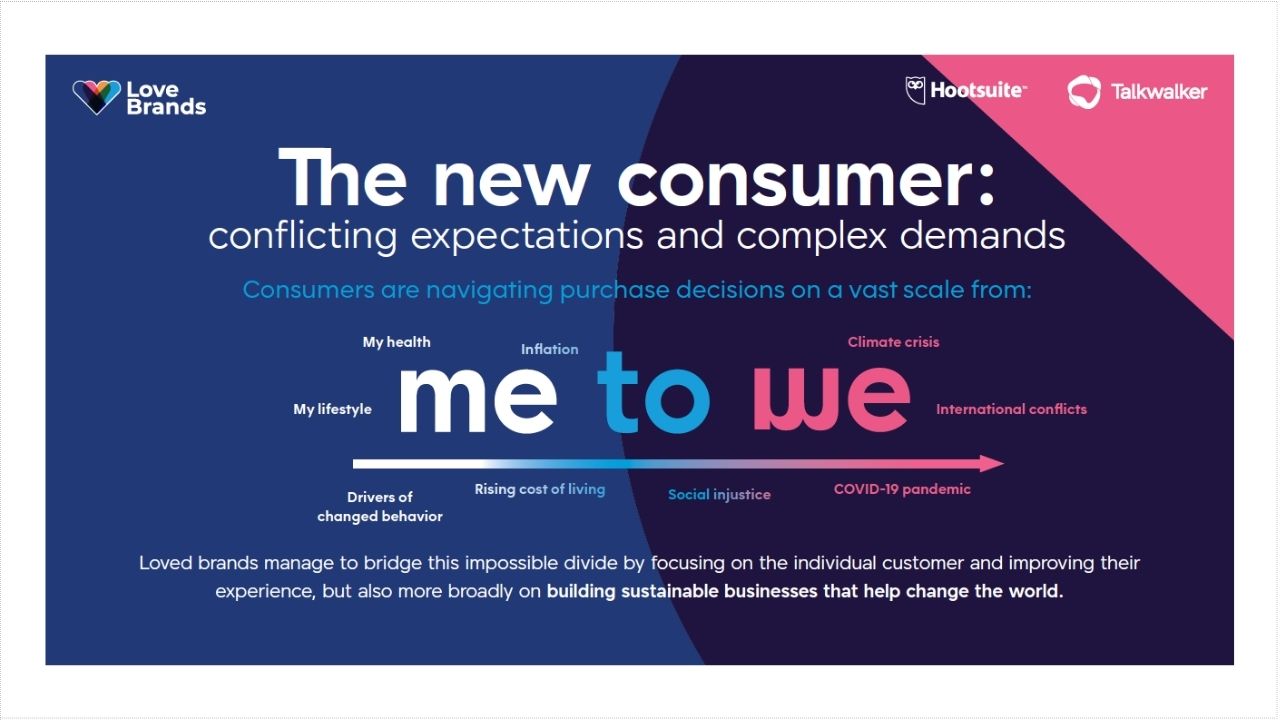
In the report, Talkwalker emphasizes that brand love is the strongest indicator of a healthy relationship between a company and a consumer. Here are some thought-starters on how brands can achieve this:
- You need a good product. Companies like Apple are innovative and stylish, and they have swagger. When you walk into a Starbucks and pull out your MacBookPro, people get jealous. They crave what you have.
- The product needs to work. With Apple, there is no setup necessary. You plug it in, and it works all the time.
- The customer experience needs to be memorable. So the online experience, e-commerce platform, iTunes, Apple T.V., the in-person experience at the Apple Store, and the unboxing of a new MacBookPro are all consistent. It’s a beautiful process and makes customers feel special.
- You need to have clear values and purpose. For example, a brand like Apple has company values that align with its customers and create a deep emotional connection. It’s that connection that keeps customers buying more, and more, and more.
Data suggests marketers are finally catching on to the importance of building brand love with their constituencies. According to KPMG and Forrester, companies prioritizing customer-centricity grow nearly 3x faster than the industry average.
3 Characteristics Drive Brand Love
Talkwalker suggests three characteristics that foster brand love–passion, customer satisfaction, and trust. The Brand Love Index is built from these three scores, each weighted differently.
Passion: Text analysis measures passion, whether positive or negative, about the brand. This also included keywords, images, emojis, and punctuation. Nothing ignites a relationship more than passion. Consumers are looking for brands that share similar values: this is who I am and what I care about, and you need to care about that. 48% of Millennials will only buy from companies that align with their values, according to the 2022 Future Consumer Index.
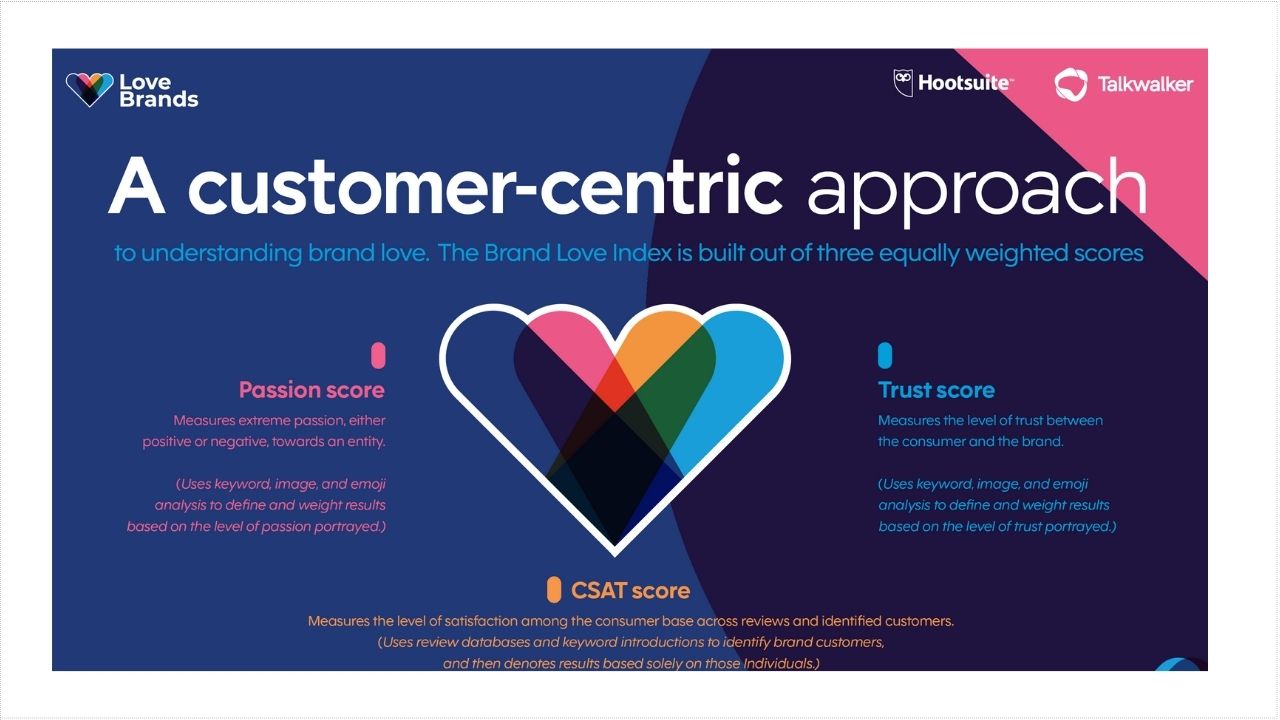
Customer Satisfaction (CSAT): CSAT measures consumers’ satisfaction levels using primary research or scraping and analyzing review sites like G2. Brands can differentiate themselves by adopting a “customer-first” culture. Doing so will bring integrated and memorable customer experiences across the entire brand digital ecosystem.
Trust: Gaining trust in 2022 and moving forward means actively listening and taking action. Consumers are tired of “lip service,” demanding that companies start to stand for something and then prove it. According to Edelman, 85% of Gen Z ers say trusting a brand is critical to where they spend their money.
Brand Love By Industry
Talkwalker segmented the Brand Love study by industry, which is smart since many nuances must be considered in an analysis like this. They analyzed nine industries:
- Media, Sports & Entertainment
- Food & Beverages
- Beauty
- Retail & E-Commerce
- Fashion
- Household Goods
- Tech & Telecom
- Automotive & Mobility
- Travel & Hospitality
According to the research, Beauty, Fashion, and Food & Beverages had the highest scores of all the other industries. More specifically, Beauty & Fashion brands are incredibly vocal about their social purpose initiatives and communicate them in a way that resonates with their audiences. Media, Sports & Entertainment also scored higher than the average. On the other hand, travel & Hospitality struggled, and for a good reason–lack of travel and forced Government restrictions once the COVID mandates were lifted.
The Top 10 Most Loved Brands in the U.S.
So, here it is—the Top 10 Most Loved Brands in the U.S. I’m honestly surprised at this list, but it’s good to see that these brands are not the usual suspects that you see on other lists and reports–Nike, Apple, Southwest, and so on.
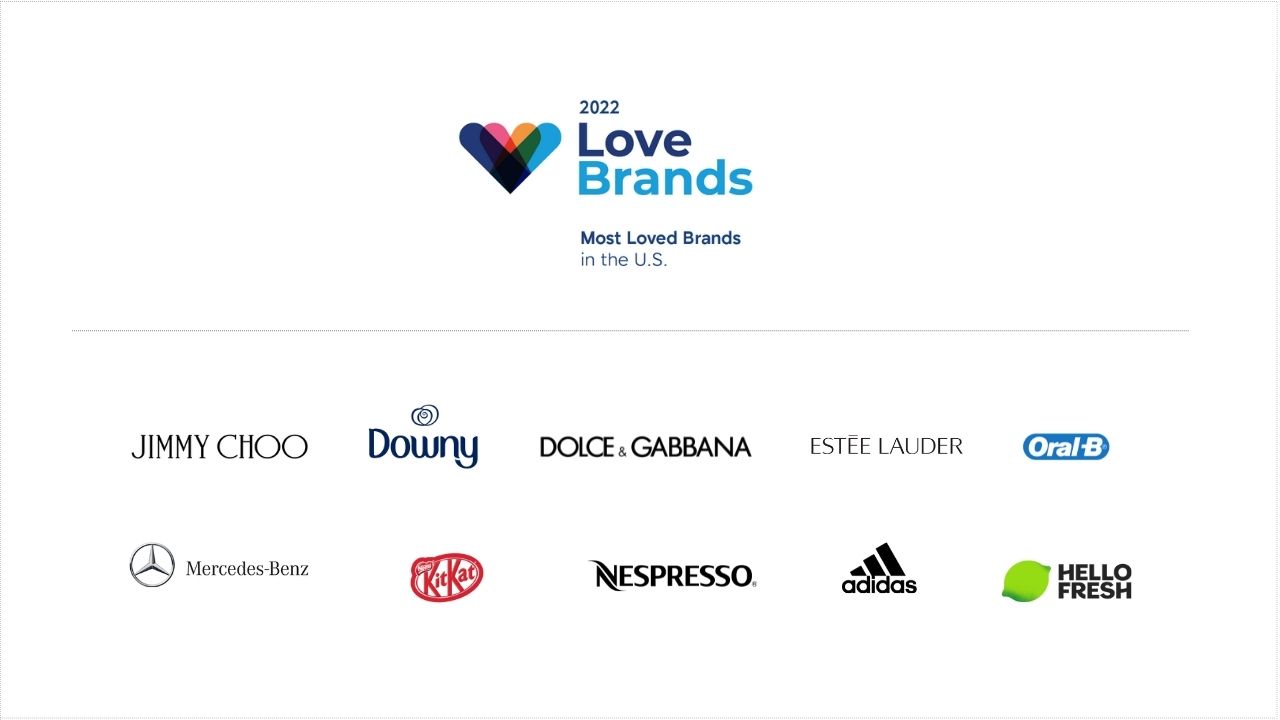
The report goes into more detail and provides examples of how each brand delivers brand love. They also offer the Top 10 Consumer Brands in the U.K., Middle East & Africa, Southeast Asia, India, Latin America, France, Italy, Germany, Austria, and Switzerland.
The Top U.S. Consumer Brands That Customers Can’t Live Without
In 2018, Prophet released its first Brand Relevance Index and a study highlighting the top brands that consumers cannot live without. You’ll notice many of the same companies in most other studies, minus the one above from Talkwalker.
The Brand Relevance Index comprised four main principles, and the top companies were stack ranked in each one:
- Customer Obsessed: The customer is engrained in everything they do internally and externally. Customer obsession is an integral part of the culture. It’s in the DNA of the leadership and employees. Every product they introduce is designed to meet unmet customer needs. These are the companies that consumers can’t imagine living without (Netflix, Pixar, KitchenAid, Trader Joe’s.)
- Ruthlessly Pragmatic: The top brands ensure their product meets customer needs and is available when and where they need them. They deliver consistent customer experiences and never let their customers down. These are the companies the consumers depend on (Keurig, Intuit’s Turbo Tax, Chick-fil-A, Kleenex.)
- Distinctively Inspired: These brands are not only superior storytellers, but they deliver on their promise. They consistently provide experiences that foster emotional connections and make people smile. These companies inspire their customers (Pinterest, Lego, Food Network, Nike.)
- Pervasively Innovative: These brands deliver innovative experiences today and always think about what’s next. They are early adopters of new ways to engage with customers, not afraid to challenge the status quo and deliver on unmet needs. These are the innovators of customer engagement (Sony PlayStation, Dyson, Marvel, Google.)
What makes the top brands in the U.S. unique is the rational and emotional experiences they give consumers, allowing them to feel connected when they use them, feel them, wear them, or spend time with them.
The top companies are committed to staying ahead of customer needs and market trends. But, more importantly, they have the discipline and rigor to execute the insights they uncover. These industry insights form the foundation for the ideas that become game-changing customer experiences and innovations. Below is a snapshot of the Top U.S. Brands according to the index.
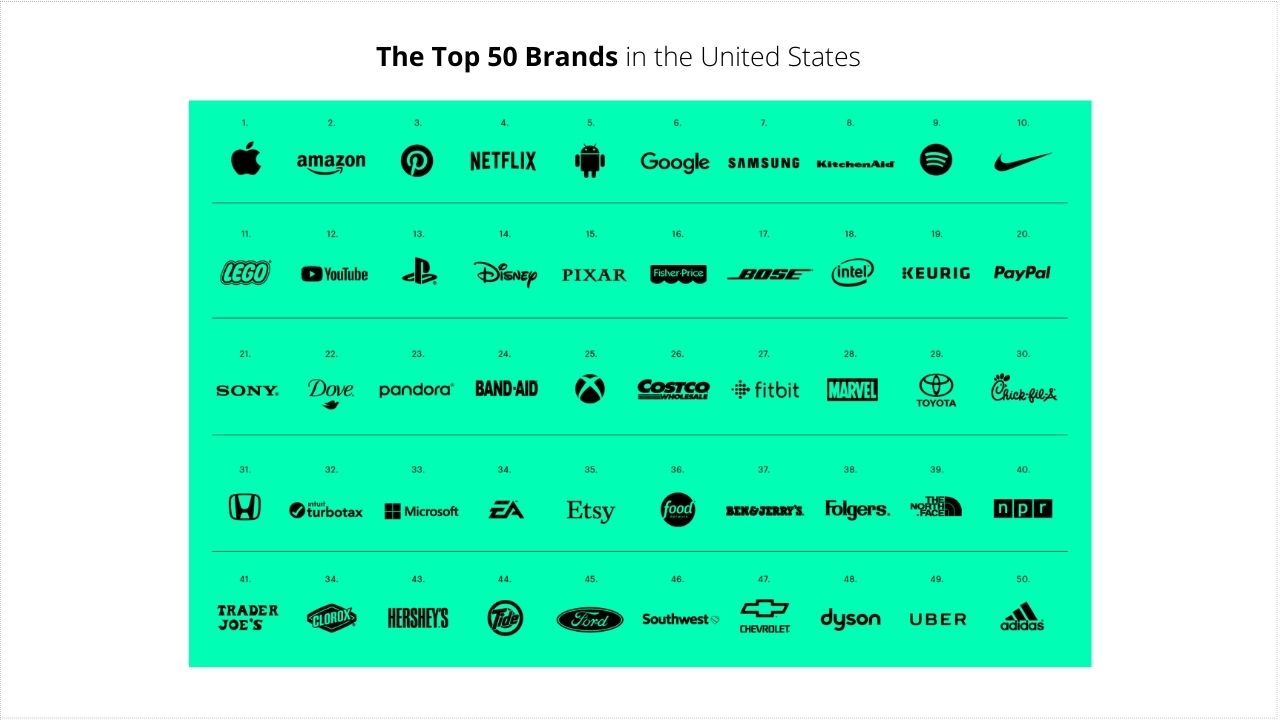
According to the report, over half of the top 50 brands fall into media, technology, electronics, gaming or social media, and internet services categories. Reviewing the highest performers in each category have been known to reinvent themselves based on four key insights: inspired innovation, data & dependability, customer experience, and targeted yet inclusive.
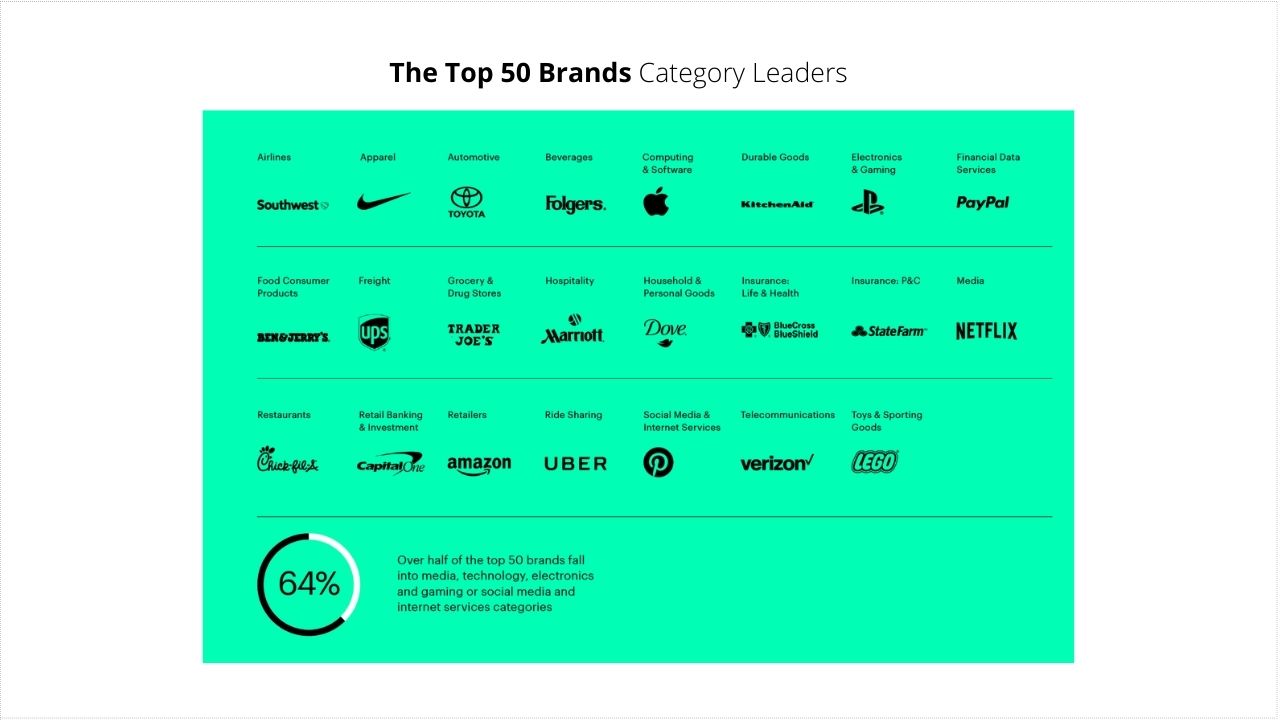
The Brand Relevance Index (BRI) was created to help business and marketing leaders measure brand relevance and provide ways to improve it. Large and small brands from all industries contributing to household spending were included in the index. The data was sourced from the U.S. Bureau of Labor Statistics.
Who are the Best Brands on Social Media?
I don’t know how many “best brands on social media” lists I have seen over the past 15 years floating around my inbox or while scrolling my news feed. I have read reports from eMarketer, Prophet, and hundreds of other research-based analyst firms, but this one got my attention.
I’m probably a little more excited than I should be about Infegy’s Top 50 Most Popular Brands report. Is it a report, a list, a PDF document … or what?
Infegy is a social media monitoring platform with strong text analytics and natural language processing capabilities. The dashboard is cool to play around with and keep track of the best brands on social media. I have also demoed and used Infegy, and they are strong players in the space.
I might do a few things differently if I were doing this analysis. I might want to look at unique mentions of a specific brand. In other words, if I were to pull in all of Amazon’s data, I would want to filter out all mentions of the other brands in the data set. I think it would show a stronger brand affinity in this regard.
For example, “my favorite brands or Amazon, Apple, and Google” on social media are very different from “I love Amazon. It’s easy to shop, I get my shipments on time, and the return policies are so easy.”
Also, I might want to filter out any link sharing to specific social media channels. Out of the top 10 best brands on social media, almost 50% of them are social networks themselves. It’s not uncommon for people to share content linking to other content across all their channels. It’s also important to note that many of these companies have active brand advocacy programs, activating their customers across all channels to amplify branded content.
Here’s another example.
I have a YouTube channel. It’s not uncommon for me to share my videos across other channels like Twitter, LinkedIn, and even Instagram. I assume my link sharing would be considered a social media mention for YouTube.
I have never said anything like this publicly, but let’s assume I say, “I love using YouTube because it drives organic visibility in Google for all of my content.” I have witnessed others say this, so it’s not completely random. The context of link sharing and my comment about the utility of YouTube are very different and shouldn’t be equal.
Ok, so no more playing Monday morning quarterback. The social media dashboard is hot, and I’m glad Infegy is providing this data to the larger online business community.
Related Content:
